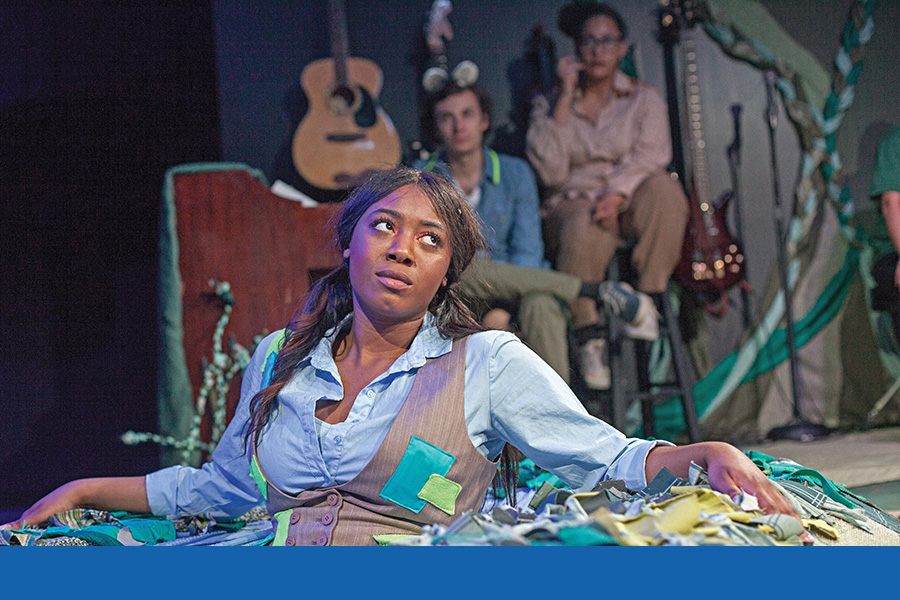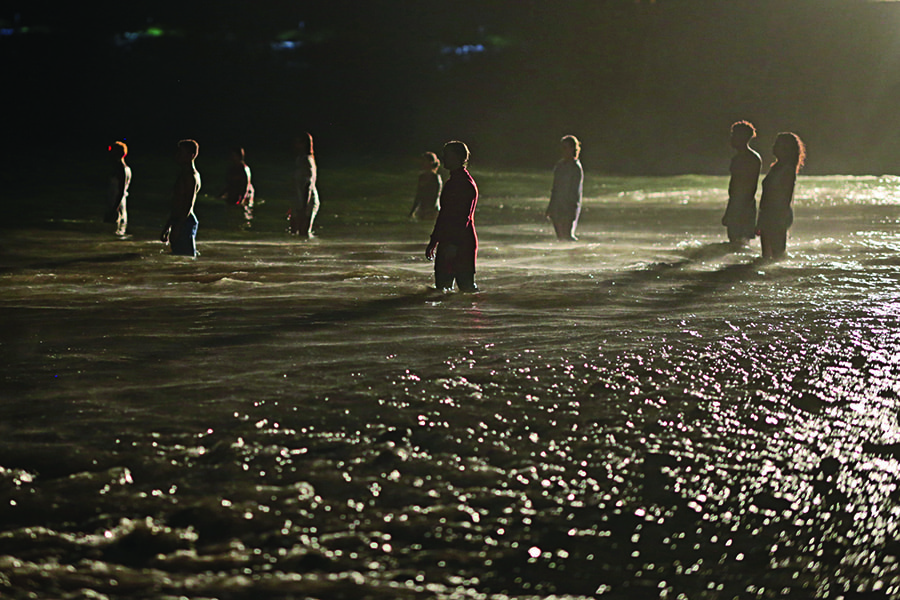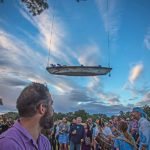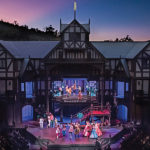This story is part of a special issue on theatre and climate change; the whole package is here.
When the global climate crisis we’re facing appears in mainstream media, it is typically portrayed in one of two ways: either as the inevitable apocalypse, futile to resist and too overwhelming to talk about, or as just another issue to overcome with the right legislative agenda, technological ingenuity, market savvy, and reusable straws. Both of these narratives perpetuate destructive myths, rooted in the same oppressive systems that caused the climate crisis in the first place.
In fact, what we face is more complex and all-encompassing. Punctuated by sporadic superstorms and wildfires, climate change is a slow, permanent warping of everything we count on as stable: solid ground, seasons, birdsong, vegetables, vacations, tap water, the foundations of a house, the fabric of a neighborhood, a parent’s confidence in their children’s future. Climate change is our new reality. To meet it, we urgently need new practices that model a regenerative culture in place of our extractive one.
Though it may not always feel like it, we wield great power as theatre artists. Our work embodies the characteristically human practice of actualizing ideas. We imagine worlds and then build them through collective action. Functioning as a microcosm of society, theatre is uniquely positioned to create the cultural conditions needed for alternative structures of power and economies to thrive. And because the climate crisis demands change at every level, every theatremaker can participate by shifting our practices to center climate justice in our work, regardless of the content of what’s onstage.
To be clear: Climate justice is not the same as going green. Climate justice is holistic; it’s about equity and sustainability beyond material considerations. For instance, while reducing the use of plastic is essential, what we ultimately need is to upend the structures of power and systems of production that have created a disposable culture so reliant on plastic. We must start by asking the questions at the heart of the problem—i.e., in what ways am I perpetuating white supremacy? How is my theatre complicit in prioritizing capital at the expense of my community? Who is missing from the room when decisions are made about the future?
Across the U.S. we’re seeing a wave of leadership transitions; increased efforts to make inclusive, non-hierarchical spaces; greater recognition of Indigenous rights; equitable pay initiatives; and more productions led by artists rooted in historically marginalized communities. These necessary first steps toward justice are serving to expand and redefine the cultural ecology of U.S. theatre. If theatre is indeed a microcosm of society, this is good news for climate justice. It means we already have the tools and knowhow to begin building a better world.
“Offstage, our organizational structures are predominantly hierarchical, patriarchal, and top-down,” say Ronee Penoi, Annalisa Dias, Anna Lathrop, and Tara Moses, the leaders of the Washington, D.C.-based Groundwater Arts, a company led primarily by women of color and Indigenous women. “Our funding structures are intimately tied up with the systems of power of our world,” they continue, “with fossil fuels, [and] with those individuals that have acquired wealth from inequitable systems and would seek to maintain those systems.” In response, Groundwater has created Green New Theatre, “a movement-building tool that provides a set of six actionable principles for the arts sector.” Green New Theatre, available online, remains a living document rooted in an emergent approach, shaped by many voices united in action.
At the frontlines of the climate crisis are communities whose physical and sociopolitical geography makes them most vulnerable to climate impacts and whose history of resilience makes them most qualified to lead. These frontline communities are overwhelmingly Black, Indigenous, and People of Color (BIPOC). Their proximity to danger is neither a coincidence nor a choice, but the result of hundreds of years of systemic oppression, a legacy of settler colonialism and white supremacy that continues today. These frontlines comprise neighborhoods that thrive despite being close to highways and far from healthy food; youth who excel despite schools built on toxic waste and homes poisoned with lead; activists who defend rights despite their land being bisected by pipelines and their forests razed for cattle; families who rescue other families in public housing th at is first to be flooded and last to receive aid.
“Native Americans, who are the stewards of Turtle Island [North America], are bearing much of the brunt of climate change, as well as leading the charge in efforts to combat it,” says Ryan Victor “Opalanietet” Pierce, member of the Nanticoke Lenni-Lenape nation and artistic director of Eagle Project, an inter-tribal and multicultural performing arts company. “The Native tribal nations of Turtle Island lived here for thousands of years, and their values will come to represent the future.”
Centering the leadership of frontline communities is key to climate justice. We need to actively learn, on a foundation of reciprocity, from worldviews that offer alternatives to settler-colonial structures. In a 2015 interview with David Mura, Rhiana Yazzie, citizen of the Navajo nation and artistic director of New Native Theatre, said, “I started to see how Indigenous people organize their world differently. We have a basically different organizing principle than European, Western, Cartesian, Judeo-Christian worldviews…In so many of our stories, we helped create the world. And that’s why we are responsible to the world. And that’s why we put relationship first.”
Primary to a regenerative culture is strengthening our relationship to place—to the multispecies ecosystems in which we live and make theatre. This work demands that we understand and come to terms with how our places are transforming due to our new climate reality. In New Orleans, for instance, flooding and erosion are “creating coastal towns that are vanishing, economic hardships, and regional climate refugees,” says Lauren Turner, founder and artistic director of No Dream Deferred. Nick Slie, co-artistic director of NOLA-based Mondo Bizarro, reflects, “In the last 40 years alone, we have seen more of our shoreline fall prey to the waters lapping at our banks than any other region in the world.”
As climate impacts increase, Turner and Slie have both shifted their practices. “No Dream Deferred prioritizes cultural relevance for our community audiences, so if climate change and questions around how we adapt to our ever-changing environment are on everyone’s heart and mind, then we believe it’s our responsibility to create theatre that speaks to that. Even if folks don’t know what to call what we are experiencing, we want to be a space where our community can learn more, together,” says Turner.
“Despite the astonishing amount of legislative and scientific responses to climate change occurring in our region of the world,” says Slie, “there are shockingly few opportunities for those on the frontlines to have a voice in discussions about the future. There is simply no space for the profound emotions of loss and grief we are currently experiencing. This is where we, as artists and cultural organizers, can create experiences that demand spaciousness for the communities with whom we are engaged.” Mondo Bizarro and ArtSpot Productions’ Cry You One, a multimodal outdoor processional performance, was made over the course of six years in deep collaboration with the community. “We are trying to physically model ideas about how we can learn to live with fluctuation, to live with uncertainty, to live in symbiosis with our increasingly watery world,” Slie explains. “Here in Louisiana, there will soon be no other choice.”
TeAda Productions, based in Santa Monica, Calif., calls itself “a nomadic theatre of color rooted in the stories of immigrants and refugees.” A recent project, Masters of the Currents, was created in collaboration with the Micronesian community living in Hawai‘i. “Climate refugees from the Federated States of Micronesia are all leaving their homelands because their island nations are becoming uninhabitable,” says TeAda co-artistic director Ova Saopeng. A recent International Panel on Climate Change (IPCC) climate report calls it “virtually certain” that global sea level rise is accelerating, and asserts “high confidence” that warm, salty seawater will degrade fresh groundwater resources and coral reefs within this century, wiping out the basic necessities and livelihoods of small-island dwellers.
The collaboration was instructive on many levels. Says Saopeng, “As artists we naïvely came in thinking, ‘We’ll work with Micronesians,’ [but we] learned quickly from the community that identity was more complex than we had realized, and the issues they were facing more imminent. Along the way in the process, we found a cultural navigator, Innocenta Sound-Kikku, who through cultural protocols opened up opportunities to engage with elders and youth.”

(Photo by Jennifer Seastone)
We, the writers of this article, co-direct Superhero Clubhouse, an interdisciplinary eco-theatre organization based in New York City. This spring marks the 10th anniversary of Big Green Theater (BGT), our eco-playwriting program for North Brooklyn public elementary students that “uplifts the imaginations of young people most impacted by our new climate reality and brings their ideas to life onstage.” We run BGT with the Bushwick Starr, a vital presenting house and incubator space that works hard to counterbalance their impact as gentrifiers in their namesake Brooklyn neighborhood by partnering with schools, social justice organizations, and local politicians to create avenues of exchange with the community.
The threat of another Hurricane Sandy dominates images of NYC’s climate fate, but for inland neighborhoods like Bushwick, the threat of asthma and heat stroke is a daily reality. Our students channel what they learn about these problems through their unbounded imaginations, with stories about regretful old factories, mutant butterflies, activist oysters, and kids who don’t hesitate to stand up to adult authority. BGT reflects our organization’s holistic approach to environmental justice: from the content of the plays to the people we work with, from the way we make decisions to our ecological production practices, which include solar-powered lighting, repurposed design materials, and rehearsal composting.
Relatively speaking, the material impact of the entire theatre industry can’t hold a candle to the footprint of other sectors of U.S. production. But our size can also be key to our ability to innovate. We are the garage start-ups of the cultural field, nimble enough to instigate large-scale change through small-scale experimentation. Something as seemingly insignificant as choosing which batteries we use can shift culture. Molly Braverman, director of Broadway Green Alliance, the nonprofit responsible for switching Broadway’s marquees to LEDs and for a nationwide Green Captains program, says that the Broadway staging of Wicked “used to go through 15,000 single-use batteries [in one year]. Now they use only 96 rechargeable batteries. Once they began this practice and demonstrated that rechargeable batteries were reliable and effective in microphones, other [theatres] followed suit.”
To give another example: The theatre department at New York’s Barnard College is rethinking traditional, linear design models (take, make, waste) and learning to shift to a circular system. Their key innovation: The materials line of their budget is divided into New vs. Used, Reclaimed, Stock, or Salvaged. This allows them to quantify their environmental impact. If their 2016 production of Some Hero had been built new, it would have generated 10 metric tons of carbon dioxide—the same amount an average home in the U.S. emits in an entire year. Instead, they were able to reduce 50 percent of these emissions by replacing half of the new materials with used. As Barnard associate professor Sandra Goldmark writes in the journal Theatre Design & Technology, “Of the 22,000 American shows tallied annually (TCG, 2013), if each of these shows [reduced emissions] by 50 percent, it would prevent nearly 120,000 metric tons of CO2,” roughly the equivalent of 12,000 average American homes.
In some cases, material adaptations have had to be made in response to immediate crises. The Oregon Shakespeare Festival’s beloved outdoor venue, the 1,200-seat Allen Elizabethan Theatre, has faced increasing levels of smoke due to wildfires in the nearby Rogue Valley. In 2018 the theatre had to cancel 26 of its outdoor performances during a month of poor air quality, leading to a loss of $2 million in revenue. Writes Alison Carey, director of OSF’s American Revolutions commissioning program, “It’s hard to capture the impact on workload and the grueling effect of uncertainty on everyone who works at the Festival.” But, she adds, “The response from staff to this crisis has been and continues to be extraordinary,” as they have recognized that they belong to “an interdependent ecosystem of human lives, business undertakings, and natural wonder.” Thanks in part to a 2016 grant from Literary Managers and Dramaturgs of the Americas, Carey and OSF’s director of literary development and dramaturgy, Amrita Ramanan, have led company in taking steps to mitigate climate impacts, from retrofitting the outdoor theatre to better withstand smoke to lowering their collective carbon footprint. OSF’s solar array with battery storage for their multistory scenic and costume facility now meets 55 percent of the building’s electrical needs. They’ve purchased an electric rideshare vehicle, and are distilling their own water, reducing shipping, and developing a practice called greenturgy, which spotlights the ways that all plays exist in relationship to their natural environment.
At the other end of the country, hurricanes, not fires, are directly threatening productions. “Hurricane Irma [shut] down our electricity and our sewer stations, which resulted in us having to cancel the first production of our season,” relates Kristen Coury, founder, producing artistic director, and CEO of Gulfshore Playhouse in Naples, Fla., referring to the Category 5 storm that hit the Florida coast in September 2017. Their building was flooded for two weeks, then filled with mold due to the humidity. Gulfshore is currently building a new theatre and education center with plans to incorporate recycled local materials—and to raise the building up three feet so it can serve as a community hurricane shelter.
The climate crisis is also driving creative experimentation. Artists are building, then dismantling indoor forests over the course of 24 hours; writing operas that have no music; structuring processes to mimic the behavior of mushrooms; exploring themes of healing and displacement without ever using the words “climate change”; and are inviting audiences to get on bicycles or go on hikes. As Slie of Mondo Bizarro puts it, “The enormity of the environmental crisis in Louisiana is difficult to comprehend. We found that walking for several hours during the processional performances [of Cry You One] created an opening for participants to understand where we are and how we got here in an embodied as well as an intellectual way.”
Many are inspired to push against the limitations of the theatre itself. “The expansion of my practice into visual arts and other interdisciplinary forms has everything to do with my focus shifting toward addressing my concerns about climate change,” says Sarah Cameron Sunde. In her 36.5 / A Durational Performance With the Sea, made in response to Hurricane Sandy, Sunde stands in various tidal areas around the world for 12-hour tidal cycles “as water engulfs her body and then reveals it again.” Her recent iteration in Bodo, Kenya, included planting mangrove seedlings in collaboration with Bodo’s locally driven initiative to prevent shoreline erosion. “So now there’s a 36.5 area of mangrove trees in Bodo.”
Interdisciplinary collaboration and community partnership were common practice for most of the artists we interviewed. This is no surprise: Climate resilience is strengthened by difference. Establishing frameworks for intersectional coalitions allows theatremakers to model what is possible. Superhero Clubhouse’s Fellowship for Environmental Justice & Performance was built to be one of these frameworks. It identifies two individuals from disparate backgrounds, within and beyond the arts, to receive financial and creative support to make a new performance for environmental justice. In the 2018-19 fellowship, poet Shy Richardson and climate scientist Karina Yager created a performance that follows a water droplet from a melting Andean glacier through the water cycle and into Hurricane Maria, where it joins the deluge that dumps on Richardson’s family in Puerto Rico. The piece is as personal and hopeful as the people-led resiliency initiatives blossoming in Puerto Rico.
Seeding new paths of collaboration is something everyone can participate in, at any level. Artists can work with those beyond their field to create new stories; theatres can forge partnerships with local social justice organizations to alter power structures in their communities; institutions can develop relationships with BIPOC-led businesses as part of a move to shift away from economic reliance on fossil fuel industries. Just as nature thrives on biodiversity, theatre is part of a social ecosystem that functions best through interdependence.
As the climate crisis intensifies, news of fires, floods, and droughts will become both more alarming and numbingly routine, threatening our capacity for empathy and action. How we as cultural leaders respond can make the difference between a culture of despair and a culture of hope. At a recent gathering of climate-focused theatremakers in Miami, Houston Cypress, member of the Miccosukee tribe and co-founder of the nonprofit Love the Everglades, paused a bleak conversation to remind those gathered that joy must also drive our work. Here we were, in a drowning city built upon the destruction of the Everglades and the displacement of the people who protect it, being reminded that centering climate justice should be a radical act of love: for the land and water, for each other, and for the stories we make that will shape our collective future.
Lanxing Fu and Jeremy Pickard are co-directors of Superhero Clubhouse, a New York City-based interdisciplinary community working toward climate and environmental justice.
The original version of this article erroneously stated that Groundwater Arts’ Green New Theatre is modeled on the principles of the Green New Deal proposed by Rep. Alexandria Ocasio-Cortez and other members of Congress, and also failed to note that Groundwater Arts is led primarily by women of color and Indigenous women.
Creative Credits for photos: 36.5 / A Durational Performance With the Sea. Lead artist: Sara Cameron Sunde. Big Green Theater 2019 production. Sets: You-Shin Chen; costumes: Sabrina Bianca Guillaume; lighting: Jay Maury. Masters of the Currents. Written by Leilani Chan (also direction) and Ova Saopeng; lighting: Maximillian Urruzmendi; sound: Jonah Moananu; film collaborator: Nathan Fitch; projections: Joan Osato; costumes: Cheri Vasek; sets: Eric West; cultural navigator: Innocenta Sound-Kikku. Cry You One by Raymond “Moose” Jackson and Joanna Russo. Direction: Kathy Randels; design: Jeff Becker and Melisa Cardona; choreography: Millicent Johnnie; costumes: Bear Hebert and Laura Sirkin Brown; culture bearer: Monique Verdin. The Merry Wives of Windsor by Shakespeare at OSF in 2017. Direction: Dawn Monique Williams; choreography: Valerie Rachelle; music and sound: Paul James Prendergast; sets: Regina García; costumes: Ulises Alcala; lighting: Jennifer Schriever.





